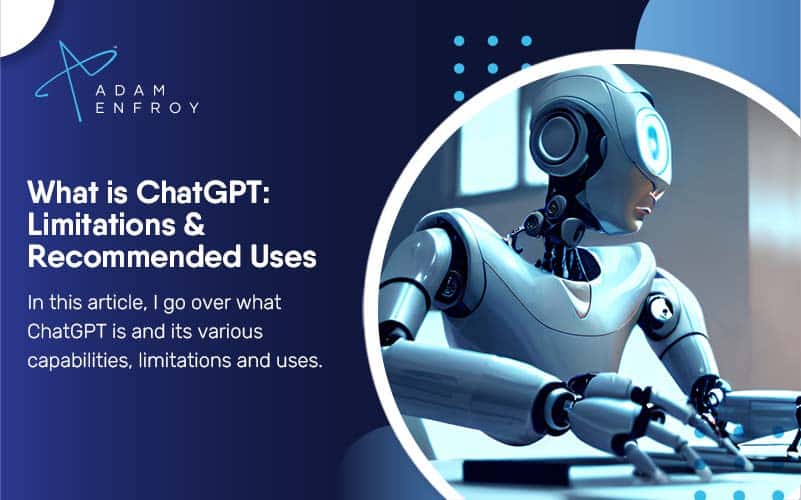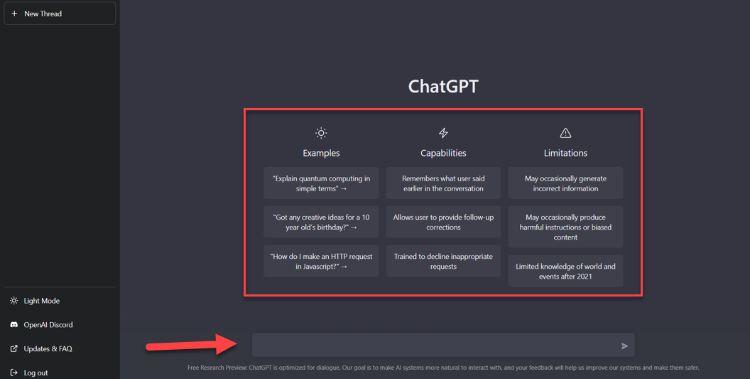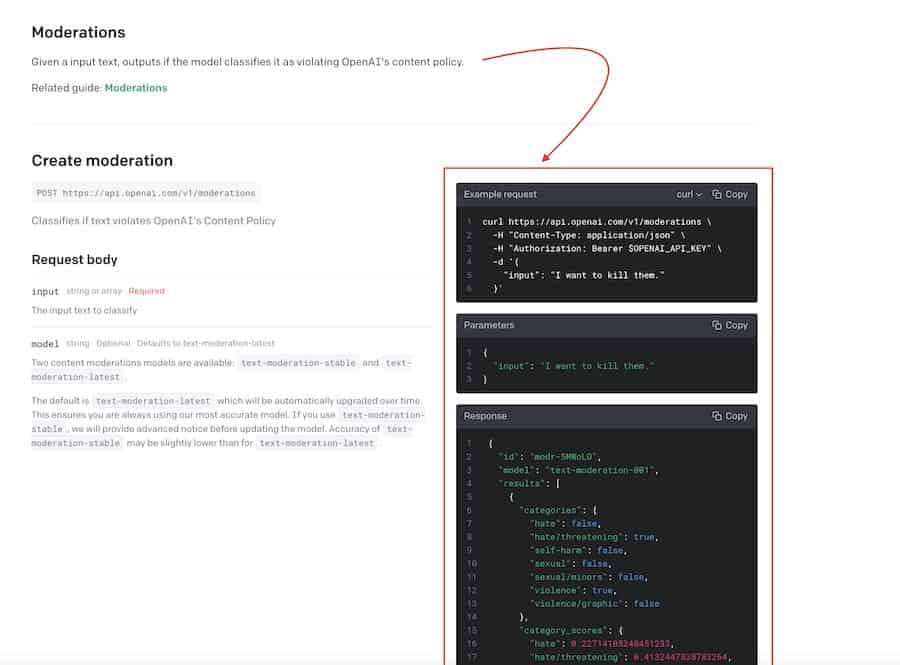What is ChatGPT: Ultimate Guide for 2024 and How to Use It

Have you ever wished you could converse with a machine and get immediate answers?
Well, now you can.
ChatGPT is an incredibly sophisticated AI model that can converse almost like a real person.
The dialogue format also allows for follow-up questions, and ChatGPT can even correct incorrect premises and reject requests outside its range of capabilities—just like a human would.
In this article, I’ll go over what ChatGPT is and its various capabilities so that you can make an informed decision about whether it’s a good fit for your business.
Whether you’re looking to make money with ChatGPT or just curious about the technology, this article will provide you with everything you need to know.
What is ChatGPT?

ChatGPT is a deep learning model designed by OpenAI that uses natural language processing (NLP) to generate conversation with humans.
It works by taking an input text and using it to generate a reply that is natural-sounding and has a logical structure.
ChatGPT runs on OpenAI’s GPT3.5 model (the next version of GPT-3), which developers trained on millions of internet documents to recognize the natural language.
This background makes it perfect for conversational applications such as customer service chatbots or virtual assistants.
The model can generate individual responses tailored to the user’s request or inquiry when fed specific prompts or commands in natural language.
What Makes ChatGPT So Special?
The most impressive thing about ChatGPT is its ability to understand the context and maintain conversations over multiple steps—something other AI models have struggled with previously.
For example, when given a prompt like “What time is it in London?” followed by “How about Paris?” the model will return an appropriate response for each city without needing to be prompted again for the second query.
It also can correct incorrect premises and reject requests outside its range of capabilities—just like a human would.
But what makes it produce the high-level output it does?
InstructGPT, an algorithm developed through the fine adjustment of early GPT-3 models, had a say in the current version of ChatGPT.
InstructGPT can do various things, including:
- Understanding and following English instructions better than GPT-3
- Answering commands defined with a prompt
- Producing less biased or toxic outputs
Both models are pushing boundaries in artificial intelligence daily and are revolutionizing how businesses interact with customers and manage tasks more efficiently.
However, ChatGPT can do even more.
Notable features of ChatGPT include its large language models, its capacity to maintain conversations over multiple steps, and its ability to correct incorrect premises or reject requests outside its range of capabilities.
Whether you’re a startup or an established business, ChatGPT stands out among other AI-based text generators because of its user feedback features and intuitive design.
Unlocking the Power of AI with ChatGPT and GPT 3.5
Taking things a step further, OpenAI’s latest GPT 3.5 language model is the most advanced.
It uses deep learning to generate natural-sounding conversations.
ChatGPT is a tool developed specifically to utilize GPT-3 capabilities, allowing users to create AI conversations with others by providing input information in natural language.
By combining the power of both models—ChatGPT for understanding conversations and GTP 3.5 for generating accurate responses—you can create modern chatbot solutions that are more natural and engaging than ever before.
All this paves the way for revolutionary new customer service experiences across multiple industries.
How GPT-3.5 Works
GPT-3.5 takes things to the next level by introducing RLHF (Reinforcement Learning from Human Feedback – more on this later).
This technology allows for more accurate conversational responses based on real human feedback.
Instead of relying solely on pre-programmed scripts or predetermined dialogue, AI can draw upon its massive database of information to create sophisticated conversations that sound much more natural than before.
It is capable of complex and precise answer generation in response to written prompts, with the ability to answer correctly even in ambiguous cases.
Based on its natural language processing system, it can answer questions using machine learning algorithms, detecting context from a given sentence and responding accordingly.
Being a computer program that can learn from wrong answers and improve itself over time, businesses can use this new AI tool to create more efficient and accurate customer support solutions.
It can also help companies automate their decision-making processes and accept or reject requests outside their range of capabilities with ease and accuracy.
How RLHF Works
The RLHF process randomly selects pieces of dialogue crafted by the model for further fine-tuning with Proximal Policy Optimization (PPO).
The PPO algorithm helps refine the reward model by using a set of parameters to adjust the training process based on its ability to collect user feedback.
Doing this ensures that the large language model can learn more effectively from its mistakes and improve its accuracy over time.
This recursive feature ensures that trainers can provide meaningful feedback that can help direct the learning process positively.
ChatGPT also allows for multiple iterations of training between trainers and chatbots, making it easier for developers to refine their AI models quickly and efficiently.
Challenges Faced By ChatGPT
Despite its many advantages, ChatGPT does have some drawbacks that developers must address if it is going to reach its full potential.
One such issue is its need for source truth during training, as the model relies heavily on generated data from previous interactions.
As a result, the tool can produce problematic model outputs comprised of incorrect or nonsensical answers due to errors in the training data sets.
Additionally, some users have noted excessive verbosity when using the model.
Said differently, the tool can generate too much information when answering a question or query.
ChatGPT needs help understanding particular topics, such as abstract philosophy or complex issues related to politics, economics, or science.
Additionally, it has difficulty understanding irony and sarcasm.
Another significant challenge faced by ChatGPT is that it can exhibit biased behavior.
Following an initial statement or query, follow-up questions may be misinterpreted and lead to ChatGPT’s responses being inappropriate.
One of the most concerning issues faced by ChatGPT is harmful instructions.
Given the power of AI and its ability to learn, it is crucial to ensure that ChatGPT does not become a tool for producing malicious instructions.
As such, the focus is to find a way that ensures ChatGPT writes plausible-sounding responses that align with ethical standards.
To deal with such challenges, you might also want to check out this list of ChatGPT alternatives.
OpenAI’s Moderation API
OpenAI designed its Moderation API to ensure that all user interactions are safe, secure, and appropriate for all ages.
By leveraging sophisticated filtering capabilities, the Moderation API can make the model refuse inappropriate requests while detecting inappropriate words and phrases in real-time.

This technology helps keep users safe while allowing them to enjoy interactions with ChatGPT’s conversational technology without worry.
ChatGPT: The Future of Search Engines?
Although Google has already made great strides with LaMDA (here’s a direct comparison between LaMDA and ChatGPT), OpenAI’s ChatGPT threatens to revolutionize the search industry by replacing traditional searches entirely.
Some even call for this new chatbot to replace Google as a search engine.
Could we soon see an era in which our questions are answered not through complex algorithms but by conversation?
It seems possible now that OpenAI has released ChatGPT.
That said, further improvements are necessary before people adopt ChatGPT on a large scale.
Until then, we can only wait and see what the future holds for this revolutionary technology.
The Implications of ChatGPT on Various Industries
Here are a few industries on which ChatGPT could positively or negatively impact.
Educational Implications
ChatGPT is already being used in some educational settings to help students learn how to write better.
It helps them hone their grammar and spelling skills while providing feedback on their writing style.
This technology could assess student performance and provide personalized guidance based on each individual’s needs.
But there is also a downside; students might become overly reliant on ChatGPT, resulting in lower-quality work and less creativity.
Job Market Implications
Despite a negative outlook due to a weak job market, new opportunities are emerging from this rapidly evolving AI system.
ChatGPT could significantly impact the job market for knowledge workers such as writers, editors, researchers, etc., who rely heavily upon their writing skills for employment opportunities.
With ChatGPT able to produce content much faster than humans, it may replace humans in specific roles or eliminate jobs.
With the job market being a constantly trending space and ChatGPT’s ability to provide personalized responses to customers, businesses may find it an invaluable tool in helping recruit suitable candidates quickly and cost-effectively.
Whether you’re a research company looking for the right talent on LinkedIn or an individual looking to find the perfect job through social media, ChatGPT provides a unique opportunity to identify what you’re looking for quickly.
Cyber Security
Regarding moderation, ChatGPT could monitor user interactions and detect suspicious activity in real time.
This possibility could help to reduce the chance of scams, cyberbullying, or other online abuses arising from incorrect advice.
ChatGPT for Coders
ChatGPT is a potent AI tool that offers many benefits to coders.
First and foremost, its conversational interface makes coding simpler than ever before.
It also can learn from prior conversations, so the experience becomes smoother and more efficient each time you interact with it.
Moreover, ChatGPT is a cloud-based service that can simultaneously store data across multiple devices.
That way, if you switch computers or mobile devices while coding, all your information will still be available on any device with internet access.
By logging every conversation and its outcomes, coders can track their progress easily and make informed decisions to ensure their model outputs are practical and ethical.
From using it to solve problems on StackOverflow to automating tedious tasks, ChatGPT is sure to give coders the edge they need to excel in their field.
What Can You Do with ChatGPT?
Let’s now speak about you.
With ChatGPT, your options for exploration are endless!
You can ask questions about anything from science and history to sports and popular culture.
The bot will answer you each time.
And because the GPT-3 engine is constantly learning from previous conversations, the responses get more accurate as time goes on.
Additionally, you can customize the bot to give you more personalized results; just input your preferences to tailor your conversation experience even further.
Compared to a traditional Google search, ChatGPT can provide more detailed answers to your queries.
For example, if you’re trying to figure out the population of a particular city, ChatGPT will give you an answer, plus additional information about the city’s culture and history.

As Sam Altman (CEO of OpenAI) said, “People hate searching”, and ChatGPT is designed to take the hassle out of searching for answers.
That said, always fact-check the outputs.
Unless you’re an expert, it might be tough to know what’s real and what’s not unless you double check.
AI Art
How does AI art come into play with ChatGPT?
AI art (also known as generative visual art) is becoming increasingly popular.
The DALL-E program from OpenAI is an excellent example. It takes in natural language descriptions and produces incredibly detailed images based on what it’s told.
ChatGPT can help you interact more effectively with DALL-E, giving you even better results.
With ChatGPT’s help, you can use natural language to ask for specific image descriptions.
Then, if the generations are not up to standard, you can fine-tune their details until you get what you want.
Moreover, with plenty of other AI art generators, you can experiment and create even more unique visuals.
Wrap Up.
ChatGPT is an incredible AI tool for academics, entrepreneurs, coders, and more.
It offers a range of helpful features that make your work faster and easier.
ChatGPT answers can solve queries, the platform can store data across multiple devices, and help you explore various topics more deeply than even before.
It can even write you a wedding proposal (if you want it to).
With Reuters reporting that Microsoft will expand access to ChatGPT ahead of a potential deal, embracing this technology will help its users stay ahead of the curve.
Further reading on AdamEnfroy.com: Content detection software can now tell if a human or AI wrote a content piece.
Tools like Originality.AI are vital in the battle against pure AI-generated content.
Check out this article on the best AI content detection tool if you want to explore this topic further.
Following this step-by-step guide, you can also learn how to start a blog and make money.
With AI tools now in full swing, the possibilities are endless regarding anything content-related.





